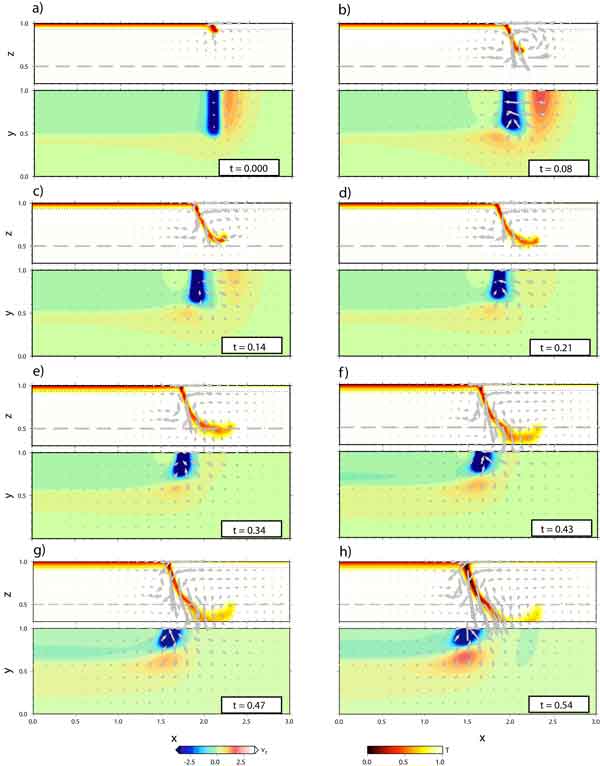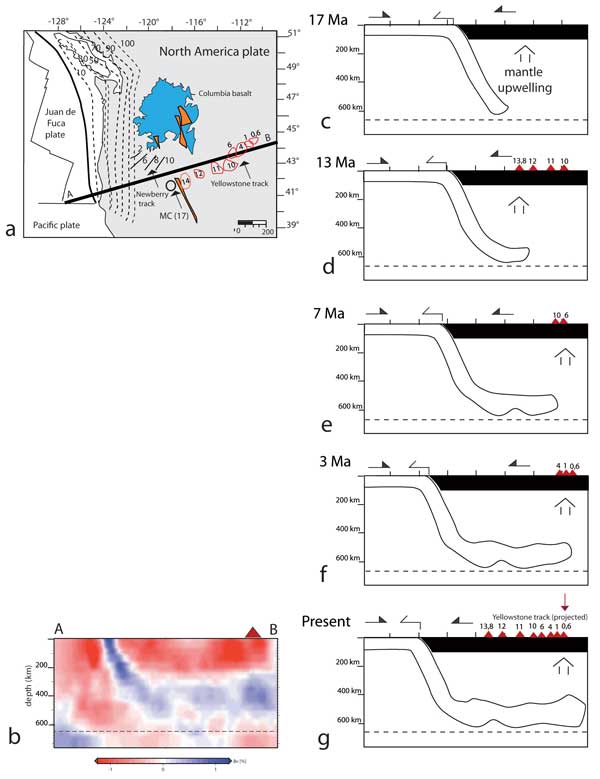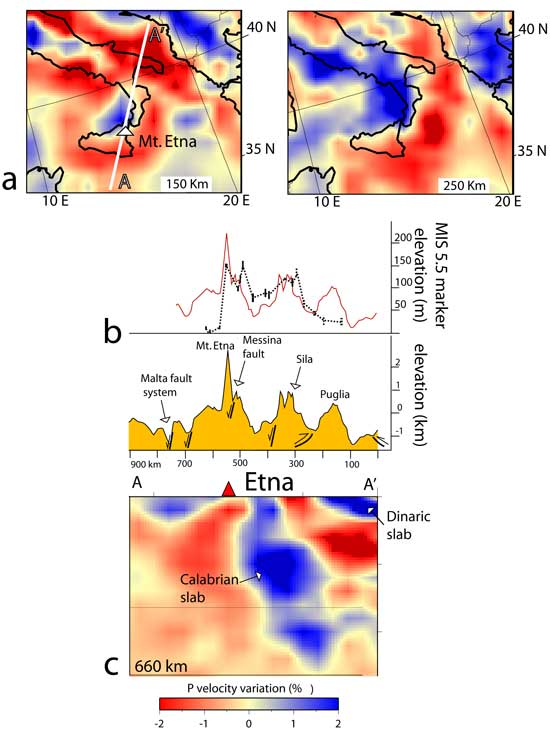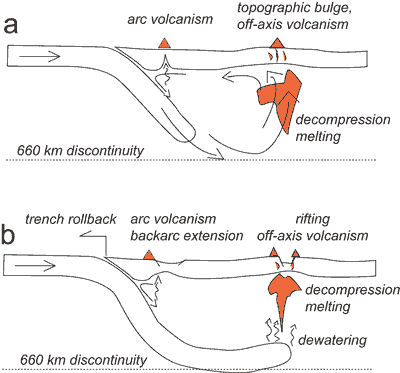 |
Subduction-triggered
magmatic pulses: a new class of plumes? |
C.
Faccenna1, T.W.
Becker2,
S.
Lallemand3, Y.
Lagabrielle3, F.
Funiciello1 &
C.
Piromallo4
1Dip. Scienze Geologiche,
Università “Roma Tre” and CNR,
IGAG-Rome, Italy, faccenna@uniroma3.it ; ffunicie@uniroma3.it
2Dep. Earth Sciences,
University Southern California, Los Angeles, USA, thorstinski@gmail.com
3Laboratoire Geosciences
Montpellier, Université Montpellier II, CNRS,
France, serge.lallemand@gm.univ-montp2.fr ; yves.lagabrielle@gm.univ-montp2.fr
4Istituto Nazionale
di Geofisica e Vulcanologia, Roma, Italy, piromallo@ingv.it
This webpage is a summary of: Faccennaa,
C., T.W. Beckerb, S. Lallemandc, Y. Lagabriellec,
F. Funiciellod and C. Piromallo, Subduction-triggered
magmatic pulses: A new class of plumes?, Earth
Planet. Sci. Lett., 54-68, 2010.
Background
A variety of thermal plumes - splash
(Davies & Bunge,
2006), baby (e.g., Wilson & Dowes, 2006)
and edge (King & Ritsema, 2000) plumes
- have been recently described as focused vertical
upwellings that are not directly rooted in the lower
mantle, as predicted by the original hotspot model
(Morgan, 1971). Moreover, high-resolution
seismological images have shown many apparent small-scale
convective heterogeneities in the uppermost mantle
at margins such as the western US (e.g., Sigloch
et al., 2008; West et al., 2009) and
the Mediterranean (Faccenna & Becker,
2010). Small scale mantle flow could explain also the
velocity distribution beneath the Rio Grande Rift (van
Wijk et al., 2008), the uplift and magmatism of
the Colorado plateau (Roy et al., 2009) and
extension beneath the Great basin (West et al.,
2009). Subcontinental small-scale convection may be
excited by sharp temperature gradients at a craton’s
edge, where decompression melting may cause volcanism
(King & Anderson, 1995). In this work,
we suggest an indirect connection to slab return
flow, which may interact with a hydrated layer in the
transition zone (Lehay & Bercovici, 2007)
to facilitate localized upwellings.
Subduction-related upwelling
In
several regions, there is evidence for volcanism that
is spatially and temporally connected to subduction
zones but not associated with mantle wedge melting.
Related magmas show ocean island basalt (OIB)-type
signatures developing from volcanoes located either
far off the arc, ahead of the trench, or at slab edges.
Relationships between subduction and anomalous volcanism,
though already postulated to explain regional cases
of intraplate magmatic activity (e.g., Changbai
volcano, East Asia: Zhao et al., 2009; New
Hebrides-North Fiji: Lagabrielle et al., 1997;
Mediterranean-European: Goes et al., 1999, Piromallo
et al., 2008, Lustrino & Wilson,
2007), have never been framed and modeled in a subduction-related
convecting system.
We demostrate that subduction within
the upper mantle triggering return flow can generate
focused, sub-lithospheric, non-thermal mantle upwellings. The
time-dependent evolution of subduction-induced mantle
circulation has been explored running 3D dynamically
self-consistent numerical models using the finite element
code CitcomCU (e.g., Zhong
et al., 1998; Moresi & Solomatov,
1995). In the adopted simplified setup, an old single
slab fixed in the far field sinks into the mantle.
This is approximated by a visco-plastic material with
temperature-dependent viscosity. The evolution of slab
sinking into the mantle (Figure 1) shows a progressive
increase of the subduction velocity during the fall
of the slab into the upper mantle (Becker et al.,
1999). The sinking slows once the slab reaches the
base of the upper mantle and it temporarily ponds where
the viscosity increases (Funiciello et al.,
2003). Subsequently, the subduction process is taken
up by trench rollback. As discussed by Funiciello
et al. (2004), the pattern of mantle circulation
is strongly variable during the three aforementioned
evolutionary stages. To describe better subduction-induced
mantle flow, it is instructive to perform decomposition
into the toroidal and poloidal components (e.g.,
Tackley, 2000).

Figure 1: Evolution of the reference
numerical model. Each panel is composed of two parts.
The upper part shows the lateral cross-section of the
model taken through the middle of the plate. The color
plot gives the magnitude of the non-dimensional lithospheric
temperature, assuming the initial mantle temperature
is fixed at 1. Arrows illustrate the x-z flow pattern
in the mantle. The lower part shows the horizontal
cross-sections taken at x km depths from the top. In
this case, the color plot gives the magnitude of the
vertical velocity component. Arrows illustrate the
x-y flow pattern in the mantle. Non-dimensional units
and unity time correspond to ~15 Ma. Click here or on Figure for enlargement.
Our modelling shows that the rapid
sinking of the slab during the initial stages of subduction,
with a dominance of poloidal flow, induces a convective
cell ahead of the slab with a wavelength on the order
of the upper mantle thickness. The maximum vigor of
the poloidal flow is attained just before the slab
encounters the 660-km discontinuity. The toroidal/poloidal
ratio (TPR) is less than 0.5 (for selected model parameters)
during slab subduction into the upper mantle and reaches
maximum values on the order of 0.6 after the slab interaction
with the 660-km discontinuity. The poloidal cell involves
upwelling components:
- ahead of the slab, mainly active during the transient
stage of slab descent into the upper mantle; and
- along the slab’s edges, active throughout
the model.
These upwelling mantle currents, combined with decompression
melting, could lead to a thinning of the lithospheric
thermal boundary layer and explain the existence/timing
of:
- some of the anomalous outside-arc alkaline volcanism;
- positive non-isostatic topography; and
- melting zones seismically recorded in the mantle
as low velocity anomalies.
Combining modeling results with natural data from key
regions - western North America (Figure 2), the Central
Mediterranean, the North Fiji/Lau Basin, the West Philippine
basin, Mt. Etna (Figure 3) and others, we confirmed
the physical relationships between subduction and anomalous
volcanism.

Figure 2: a) Map of
Western North America (redrawn from Xue & Allen,
2007). Three main magmatic provinces can be recognized:
the Columbia River Basalts, the Yellowstone Hotspot
Track (with red showing the location of magmatic centers
and related ages) and the High Lava Plains of Oregon,
or Newberry Hotspot Track (with red showing the location
of magmatic centers and related ages, and black thin
solid lines indicating the location of magmatic centers
and related ages). Dashed lines show the depth of the
subducting lithosphere. MC indicates McDermitt Caldera.
The A-B line indicates the cross-section of panels
b-g. b) The tomographic cross-section along the Western
North America margin from Li et al. (2008).
c-g) Reconstruction of the evolution of the Juan de
Fuca subduction zone and of the position of the volcanic
centers back over the last 17 Ma, starting from the
distribution of the velocity anomaly in panel b). Arrows
indicate the net motions of the subducting plate, the
overriding plate and the trench. The age of the volcanic
centers is expressed in Ma. This shows that the emergence
of volcanism occurred just as the slab arrived at the
660-km discontinuity and that the position of the volcanism
lines up with the slab tip (Figure 2b). Based on seismological
observations and plate-tectonic reconstructions, we
speculate that a mechanism of subduction-driven upwelling,
similar to the one shown in Figure 1, could be adapted
to the Yellowstone case. We also speculate that the
massive onset of volcanism in the surrounding area
could be triggered by a shallow, upper-mantle source,
perhaps triggered by the separation of the oldest portion
of the slab and the onset of the new subduction cycle
(Sigloch et al., 2008).

Figure 3: Mantle structure
beneath and around Mount Etna from the PM01 model (Piromallo & Morelli,
2003). Note the low velocity anomalies located around
the Calabrian slab. a) Sections at 150 and 250 km depth.
b) Topography and elevation of the MIS 5.5 marine terraces
along the section (from Ferranti et al., 2006)
illustrating uplift in correspondence of Mount Etna.
c) AA' cross section shown in a) of the seismic tomography
model, showing a marked low velocity anomaly around
the slab. Our modeling results show that the contradiction
between these classes of models, slab-induced asthenospheric
flow and the hot spot model, is only just apparent.
We propose that Mt. Etna can be considered an upwelling
structure confined in the upper mantle as a consequence
of the complex 3-D mantle circulation triggered by
the subducting lithosphere.
Summary
The combination of
numerical modeling and tectonic reconstructions reveals
(Figure 4):
- The initiation of strong volcanic off-arc activity
is expected during peaks of poloidal mantle circulation.
This condition is reached when the slab approaches
the transition zone. In this phase, the slab attains
its peak velocity (Funiciello et al.,
2006). The case of Yellowstone clearly shows this
correlation (Figure 2). Volcanism is likely positioned
between 600 and 700 km from the trench. During
this phase, the source of magmatism is entirely
related to decompression melting. At the surface
this process is accompanied by broad uplift,
elevated heat flow, and normal faulting.
- Volcanism remains active during the entire subduction
process. The locus of volcanism can either follow
the moving subduction zone or be rather stable once
the upwelling is rooted in the high-velocity anomaly
stagnating in the transition zone (Figure 4). It
is possible that, during this phase, slab dehydration
could contribute to melt in the asthenosphere and
feed volcanism (Richard & Iwamori,
2010). Petrological and numerical modelling are
needed to constrain this mechanism better.
- Slabs can show peculiar volcanism positioned at
slab edges. Examples of such kinds of volcanoes are
frequent (e.g., South Sandwich, Kamchatka,
Taiwan, Tonga and Mt. Etna; Figure 3). The mechanism
propelling melting is still decompression, due to
the vertical component of the upper mantle circulation
around the slab edges being active since the beginning
of the subduction process. However, it cannot be
excluded that slab dewatering could be another efficient
mechanism active in this particular position. Some
of the cited natural examples, in fact, exhibit a
complex geochemical signature that could reveal mixing
between deep components and shallow ones. Shear heating
between the slab and the surrounding mantle could
be invoked as an alternative interpretation to localized
low-velocity zones at slab edges, but its contribution
has been calculated to be extremely weak (Rupke
et al., 2004).

Figure 4: Cartoons
showing scenarios able to trigger decompression melting
produced by slab return flow, and the resulting development
of off-axis volcanism. a) Slab-mantle interaction;
b) Steady-state condition of subduction with the slab
lying on the 660 km discontinuity.
References
-
Becker, T.W., Faccenna, C.,
O'Connell, R.J., Giardini, D., 1999. The development
of slabs in the upper mantle: insight from numerical
and laboratory experiments. J.
Geophys. Res., 104, 15207-15225.
-
Davies,
H.J., Bunge, H.P., 2006. Are splash plumes the
origin of minor hotspots? Geology, 34,
349–352, doi: 10.1130/G22193.1.
-
Faccenna,
C., Becker, T.W., 2010. Shaping mobile belt from
small scale convection. Nature, 465, doi:10.1038/nature09064.
-
-
Ferranti, L., et al., 2006.
Markers of the last interglacial sea level highstand
along the coast of Italy: Tectonic implications. Quat.
International,
145–146, 30–54, doi:10.1016/j.quaint.2005.07.009.
-
Funiciello,
F., Faccenna, C., Giardini, D., 2004. Flow in the
evolution of subduction system: Insights from 3-D
laboratory experiments. Geophys. J.
Int., 15,
1393–1407.
-
Funiciello, F., Faccenna, C.,
Giardini, D., Regenauer-Lieb K, 2003. Dynamics
of retreating slabs (part 2): insights from 3D
laboratory experiments. J.
Geophys. Res., 108, doi:10.1029/
2001JB000896.
-
Funiciello, F., Moroni, M.,
Piromallo, C., Faccenna, C., Cenedese, A., Bui,
H.A., 2006. Mapping flow during retreating subduction:
laboratory models analyzed by Feature Tracking. J.
Geophys. Res., 111,
doi:10.1029/2005JB003792
-
Goes, S., Spakman, W.,
Bijwaard, H., 1999. A lower mantle source for central
European volcanism. Science, 286,
1928–1931.
-
King, S.D., Anderson, D.L.,
1995. An
Alternative Mechanism of Flood Basalt Formation. Earth
Planet. Sci. Lett., 136, 269-279.
-
King,
S.D., Ritsema, J., 2000. African
hot spot volcanism: Small-scale convection in
the upper mantle beneath cratons. Science, 290,
1137-1140.
-
Lagabrielle, Y., Goslin, J.,
Martin, H., Thirot, J.L.Auzende, J.M., 1997. Multiple
active spreading centers in the hot North Fiji
Basin (Southweast Pacific): a possible model
for Archean seafloor dynamics ? Earth Planet.
Sci. Lett., 149,
1–13.
-
Leahy, G.M., Bercovici, D, 2007.
On the dynamics of a hydrous melt layer above the
transition zone. J. Geophys.
Res., 112, B07401.
-
Li, C.,
van der Hilst, R.D., Engdahl, E.R., Burdick,
S., 2008. A new global model for P-wavespeed
variations in Earth's mantle. Geochemistry
Geophysics Geosystems, 9,
Q05018, doi:10.1029/2007GC001806.
-
Lustrino, M.,
Wilson, M., 2007. The circum-Mediterranean anorogenic
Cenozoic igneous province. Earth Sci. Rev.,
doi:10.1016/j.earscirev.2006.09.002.
-
Moresi, L.,
Solomatov, V.S., 1995. Numerical Investigations
of 2D Convection with Extremely Large Viscosity
Variations. Phys. Fluids, 7,
2154-2162.
-
Morgan, W. J., 1971. Convection
plumes in the lower mantle. Nature, 230,
42–43.
-
Piromallo, C, Morelli, A., 2003.
P
wave tomography of the mantle under the Alpine-Mediterranean
area. J.
Geophys. Res., 108, 2065,
doi: 10.129/2002JB001757
-
Piromallo, C., Gasperini,
D., Macera, P., Faccenna, C. 2008. A late Cretaceous
contamination episode of the European–Mediterranean
mantle. Earth Planet.
Sci. Lett., 268, 15–27.
-
Richard,
G.C., Iwamori, H., 2010. Stagnant slab, wet plumes
and Cenozoic volcanism in East Asia, PEPI,doi:10.1016/j.pepi.2010.02.009
-
Roy, M., Jordan, T.H., Pederson,
J. 2009. Colorado Plateau magmatism and uplift
by warming of heterogeneous lithosphere. Nature, 459,
doi:10.1038/nature08052
-
Rupke, L.H., Morgan, J.P.,
Hort, M., Connolly, J.A.D., 2004. Serpentine and
the subduction zone water cycle. Earth Planet.
Sci. Lett., 223,
17-34.
-
Sigloch, K., McQuarrie N., Nolet,
G., 2008. Two-stage subduction history under North
America inferred from multiple-frequency tomography. Nature
Geoscience, 1,
458-462.
-
Tackley, P.J. 2000. Self-consistent
generation of tectonic plates in time-dependent,
three-dimensional mantle convection simulations
1. Pseudoplastic yielding. Geochemistry
Geophysics Geosystems, 1, 2000GC000036.
-
van Wijk, J., van Hunen, J.,
Goes, S., 2008. Small-scale convection during continental
rifting: Evidence from the Rio Grande rift. Geology, 36,
575-578, doi: 10.1130/G24691A.1.
-
West, J.D., Fouch,
M.J., Roth, J.B., 2009. Vertical
mantle flow associated with a lithospheric drip
beneath the Great Basin. Nature
Geoscience, 2, 438-443.
-
Wilson,
M., Downes, H., 2006. Teriary–Quaternary
intra-plate magmatism in Europe and its
relationships to mantle dynamics. In: Gee,
D., Stephenson, R. (Eds.), European Lithosphere
Dynamics. Geol. Soc. Lond. Mem., 32,
147–166.
-
Xue, M., Allen, R. M. 2010.
Mantle structure beneath the western United States
and its implications for convection processes. J.
Geophys. Research, 115,
B07303, doi:10.1029/2008JB006079
-
Zhao, D., Tian,,
Y., Lei, J., Liu, L., Zheng, S., 2009. Seismic
image and origin of the Changbai intraplate volcano
in East Asia: Role of big mantle wedge above
the stagnant Pacific slab. Phys. Earth Planet.
Inter., 173,
197-206.
-
Zhong, S., Gurnis, M., Moresi, L., 1998. Role of
faults, nonlinear rheology, and viscosity structure
in generating plates from instantaneous mantle flow
models. J.
Geophys. Res., 103, 15255–15268.
last updated 23rd
February, 2011 |
